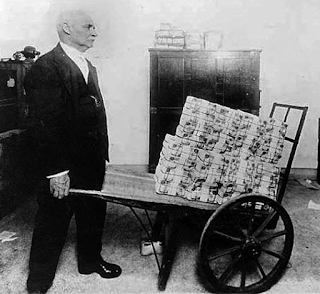It was not
until November 1923, that effective action was taken to stabilize the
currency. On November 13, 1923, Doctor
Hjalmar Horace Greeley Schacht (born in Tingleff in what is now part of
Denmark, but his parents, both German, were married in New York City, and,
apparently, admirers of that city’s periodicals) was appointed Commissioner of
National Currency. He was given a free
hand in all questions of money and credit.
His sole priority was to halt the inflation that by this time had become
an inferno.
Doctor Schacht’s
goal was to return the Reichsmark to its pre-war valuation of 4.2 to the U.S.
Dollar. The first step was to “freeze”
the inflation rate on November 20, 1923, when the Reichsmark hit 4.2 trillion
to the U.S. Dollar. It is interesting to
note that, at this exchange rate, one cent in U.S. money would have more than
repaid the entire German National Debt in 1914, several times over.
In spite of
this official fixed rate, however, currency speculators on the black market
attempted to keep inflation going, and the underground rate reached 12 trillion
Marks to the Dollar before the end of November.
As the situation came under control, however, the speculators lost large
amounts, due primarily to Doctor Schacht’s insistence on maintaining the
official exchange rate at 4.2 trillion Marks to the U.S. Dollar.
According to Doctor Schacht’s autobiography, Confessions of the ‘Old Wizard’, there were three “official”
currencies presumably in circulation at the end of November, 1923: the old imperial Gold Reichsmark, the Paper Reichsmark,
and the new Rentenmark.
The new
Rentenmark was backed by State mortgages on public lands, including the
railroads, and pegged at 4.2 to the U.S. Dollar. Issues in excess of the value of the land
backing the currency were absolutely forbidden. The old, inflated Reichsmark would be demonitized and replaced with a new, revalued Reichsmark pegged to the Rentenmark, which was in turn pegged to the U.S. Dollar. While the amount of Rentenmark non-legal tender reserve currency was strictly limited and inelastic, the new legal tender Reichsmark currency was elastic, the amount varying directly with the bills of exchange accepted by commercial banks and rediscounted at the Reichsbank, and qualified private sector securities purchased in open market operations, thereby ensuring an asset-backed, elastic legal tender currency in tandem with an inelastic, asset-backed, non-legal tender reserve currency.
Despite the seeming complexity of the system, it worked. Some
people credit the confidence that Doctor Schacht personally exuded in his new
system with halting the hyperinflation.
Doctor Schacht was appointed “President for Life” of the Reichsbank on
22nd December 1923. He served
the Weimar Republic until stepping down in 1930 over some issues regarding the
handling of certain reparations payments.
As noted, the Rentenmark
was a legal currency, but it was not legal tender. This was to prevent the currency speculators
from demanding payment in new Rentenmarks for debts incurred using old
Reichsmarks.
As a result,
due to this legal technicality (and despite the fact that the Weimar Republic was socialist), Rentenmark loans were distributed through the
Reichsbank, at this time construed as a private sector central bank instead of an effective branch of the government that Keynesian economics would demand, rather than sold directly by the government through the
Treasury. This move had the effect of
helping to restore confidence in the central bank. In order to deal at one blow with the huge
mass of grossly inflated official currency, the large amount of emergency
currency and the speculators, a short redemption period was established, during
which 4.2 trillion Marks would bring one U.S. Dollar or 4.2 Rentenmarks. The Rentenmark’s lack of official legal
tender status made it possible to use American currency as an option in the
exchange.
 |
| Rentenmarks and Pfennigs almost indistinguishable from Reichsmarks and Pfennigs |
Within a year
the currency had been stabilized to a degree that allowed the government to
re-implement a standard currency system, using the central bank, and,
presumably, issuing coin and currency in the quantities demanded by the needs
of business and commerce. This system
returned to the old name of Reichsmark, and the Rentenmark system was phased
out, although the coin and currency continued to be accepted at par with the
newer issues until 1948.
The only thing
missing from the reform was a program encouraging widespread ownership of
productive assets. This would have made
the German economy and currency the soundest in the world. One cannot, however, blame Germany for
failing to do what no one else was doing.
One of the most
terrifying immediate results of the reparations payments had been resolved, but
the resentment over reparations remained, together with the fear that the
hyperinflation could return at any time.
The country looked for a leader who could make Germany great again, and
was phenomenally successful . . . for a while.
#30#


